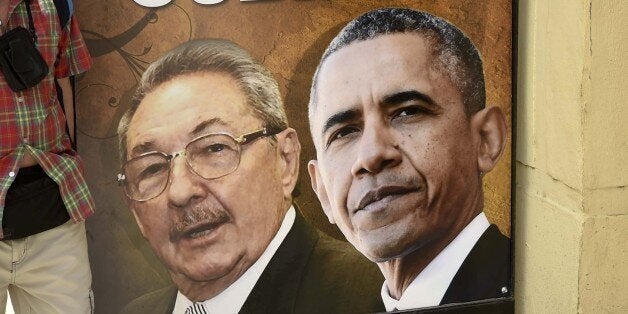
On March 21, 2016, President Obama, the relatively young leader of the most powerful nation in the world, is scheduled to meet President Raul Castro, the aged leader of a small, poor, geopolitically insignificant nation, albeit one that holds great symbolic value for Latin America and other parts of the world. The outsized symbolic value of Cuba, the weaker nation, derives from the fact that it has simply refused to do whatever the more powerful nation, the U.S., has wanted it to do for 57 years.
As a result of this standoff, the two nations have been engaged in decades of 'Spy vs. Spy' manoeuvring, a dynamic that the Cuban-American creator of the Mad Magazine's comic strip, Antonio Prohias, believed was an ingrained part of the Cuban psyche. Considering the popularity of the comic strip in the U.S., this dynamic must also lie deep in the American psyche. Such tit-for-tat dynamics might have made sense during the Cold War, but in the era of ISIS, cyber-terrorism, nuclear rogue nations, and rapidly advancing climate change, it seems simply wasteful and misguided.
Neither President Obama nor President Castro will hold office in two years. Thus, the rapprochement between the two nations is part of their presidential legacies. And they intend their policies to last. To accomplish this 'new normal,' both men are advancing their policy frameworks to the limits of their executive powers (at least on Obama's side) and within the political constraints presented by their home country constituencies. Like Caesar crossing of the Rubicon, with this visit, Raul and Obama are signaling that there is no turning back.
Getting this far has not been easy for either leader. President Obama has had to: 1) call the bluff of pro-embargo hardliners despite their threats and protestations; 2) convince the U.S. private sector that the business opportunities are worth the hassle of dealing with the unpredictable Cubans and the remnants of the labyrinthian embargo; and lastly 3) slowly broaden the perception of Cuba in the U.S. collective consciousness from that of a tropical gulag stuck in a 1950s time warp, to that of a nation of well-educated, hard-working would-be entrepreneurs who, despite their many travails, remain proud and hopeful.
President Castro, on the other hand, has had to: 1) get on-side his own set of hardliners, many of whom fought against U.S.-backed President Batista and in the Bay of Pigs invasion; 2) manage the expectations of the population for better times ahead (and for worse times if dependent on the underfunded Cuban welfare state); and 3) allow for open spaces to arise for the Cuban population to discuss further openings not only on the business front, but also on the political sphere, while resisting the kind of repressive actions that 'pushing the envelope' usually unleash.
The gods do seem to be on their side though. On the Ides of March (the 15th of the month), the native son of Florida, Senator Marco Rubio, a second-generation Cuban-American hard-liner, lost the Republican primary and retired from the race. On that day, for the first time since the 'Triumph of the Revolution', both Florida primaries were won by pro-engagement candidates (Trump and Clinton). With Florida on board, the electoral threat that made it nearly impossible for either party to ease the embargo in any significant manner -- has been dealt a near mortal blow. The only contest left, if it comes to that, is a Ted Cruz vs. the U.S. Chamber of Commerce fight.
The future of the Cuba-U.S. relationship is, nevertheless, hard to predict. Both nations are undergoing deep and confusing identity crises. As the 2016 presidential election has made evident, the U.S. is no longer a country simply polarized between liberals and conservatives constituencies. It is actually a deeply fractured collection of self-referential tribes that have little capacity to understand each other.
Cuba, on the other hand, is a 'country' made up of two communities -- the eleven million people on the island and two million in the US alone. And within each of these two joined-at-the hip (by love, hate and nostalgia) Cuban communities lays a broad amalgam of subgroups. Both sides have older more recalcitrant hard-liners and younger politically apathetic youth interested in making money and listening to Reggaeton, as well as a potpourri of races, classes, ages, religious beliefs and political leanings. And then, there are the 'transnational Cubans' those who operate freely and comfortably in both Miami and in Cuba alike.
This new 'friendship' between Cuba and the U.S. (this is, after all, also a family visit with sightseeing, baseball games and a symbolic arrival on the first day of spring) is one of the few 'feel good' stories of the second decade of the 21st century. But despite high levels of approval and generalized cheer in both nations, there is still a long hard way to go.
Pro-embargo hardliners in the U.S. have now become fixated on measuring whether Obama's 15-month old policy can bring about 'the changes' that over 5 decades of embargo failed to accomplish. And they will continue to publicly decry the 'failure' of the overall normalization policy with every minor policy reversal. The mirror discussion on the Cuban side, can be seen in the vehement declarations by Cuban leaders that it's internal matters are sovereign matters that will not be dictated by the United States, be it via carrot or via stick. Any kind of impasse between them (and there are many thorny issues from human rights to Guantanamo) or even any kind of conditionality on the U.S. side will be condemned as an affront to Cuba's national sovereignty.
And, as far as possible fireworks, we have yet to see what the reaction of the American public will be to Cuban merchants peddling their wares on U.S. main streets and to Cuban diplomats interacting with U.S. media. The lack of familiarity of the American public with things Cuban will likely make initial dealings feel like a cross between 'I Love Lucy' and the 'Twilight Zone'.
The fundamental notion underlying the positions of the two sets of hardliners described above is that -- rapprochement is simply the same old American policy of 'regime change' through different means. And this subtler stealth version of the old 'Spy vs. Spy' mentality is, by far, the biggest obstacle to the success of the normalization policy. Until the U.S. breaks it addiction to meddling in Cuba's internal affairs and until Cuba relaxes its paranoia about a wolf in sheep's clothing in every American move -- the new reality wished for by both sides simply cannot arise.
Breaking habits learned from the demands of realpolitik is very hard to do. Nonetheless, since the previous policy has not worked for either nation, perhaps something new must be given a try. A positive dynamic based on mutual respect and common concerns is worth trying. For Americans, this new way of thinking will require that they stop measuring every event in Cuba against a wish list itemizing the Cuba they would rather see. And it will require that Cubans stop thwarting their own internal dynamics of social, economic and political evolution in an attempt to maintain the kind of control that was necessary during the era of outward U.S. aggression towards the island, not to mention made possible by the bell jar created by the 'enemies blockade'. To echo the words of George Bernard Shaw, "Progress is impossible without change, and those who cannot change their minds cannot change anything."
A more 'normal' live-and-let-live model of bi-lateral relations does not, in any way, mean that either country has to abandon its fundamental values or stop advancing its own national interests. The United States must continue to pursue universal values such as freedom, democracy and human rights; and Cuba has to preserve its commitment to the essential values of a prosperous and sustainable socialism and to the protection of its national sovereignty.
This new way of thinking and behaving simply means that each nation has to stop trying to change how the other thinks and acts, as well as stop being indignant, belligerent and rash when differences arise. In sum, it is time we stop trying to change 'the other's' mind. It is time we change 'our' minds. It is time to learn to agree to disagree while continuing to pursue national interests through civilized diplomatic means. And, especially, it is time for both governments to back off and let Cuban citizens themselves explore a newly found bi-laterally engineered open space and in it build the Cuba they know is possible.
